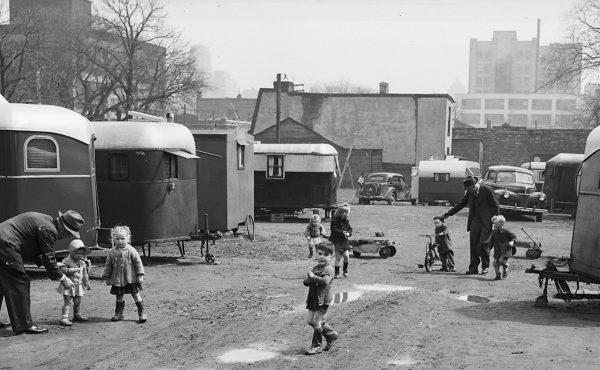
For those of us who find fault with the real estate and development industries for being more concerned with building profits than cities, October was our month to stick it to them. First it was passage of the Land Transfer Tax and then, at the end of the month, development charge increases came to the front burner.
In spite of the hundreds of thousands of dollars pumped into the campaign to kill Mayor David Miller’s Fair Taxes by the Toronto Real Estate Board and its allies, a contingent of high-profile developers swooped in at the last second to give Miller the boost he needed to not only win the vote on taxes at Council but win it convincingly.
You have to figure the developers realized that if the taxes failed to go through then development charges would sky rocket, among other necessary and more painful measures. Thus, Land Transfer Tax equals continued bargain deals on development charges, right? Wrong.
As soon as Toronto City Council finished with the tax debate, its Executive Committee moved to speed up reports [PDF] on increasing development charges. This approach is similar to most GTA municipalities, which already have higher development charges than Toronto and are increasing their take at a faster pace than Toronto, too.
From the October 31 edition of the Toronto Star:
“I think we could double or triple our current charges,” Joe Mihevc, councillor for Ward 21, St. Paul’s, told the city’s executive committee this week, citing “a gross inequity between what we charge and what they charge in the 905.”
Now developers are out on a very lonely limb, having played Tonya Harding to TREB’s Nancy Kerrigan during the taxes debate. Without the anti-tax infantry marching behind them, the development industry has few defenders who will come to their aid. I almost get the sense that industry reps aren’t even going to put up a fight on this one. They told the media earlier this week that property tax increases are fairer than levying higher development charges. I don’t think there are many who buy that argument.
The claim that people who build and purchase brand new subdivisions (horizontal or vertical) shouldn’t pay the capital cost of the infrastructure required because of their arrival is laughable. While it’s important to be judicious in setting development charges, it’s abundantly clear that the City of Toronto isn’t getting its fair share when compared to our 905 neighbours. And it surely costs more to hook up a new building to aging infrastructure in Toronto (think century old water pipes) than it does in the much more recently built burbs.
So get ready for 905-style development charges in 416. Even if you don’t like that prospect, you can take comfort knowing that Councillor Cliff Jenkins will be able to move on to another issue.
Photo Courtesy Eric Giberson.




10 comments
Development charges are an interesting beast. On the one hand, they enabled Mississauga to not raise taxes for an amazing length of time. On the other hand, look at what development has done to Mississauga… and look at the tax increases they now need to catch up. Should Toronto increase its development charges? Very likely. But Toronto’s costs to provide infrastructure are different than the suburbs. Toronto is largely built out has services everywhere in the City (though it is certainly older stock). The suburbs don’t have this luxury, where all new development is on new infrastrucure.
Toronto also has high commercial taxes.. so now it will cost more money to build, and the business will then have to pay more each year on top of it than if they located in the 905. Perhaps this is just Toronto’s way of saying “we’ve already lost most new commercial development to the 905… so fuck it.. might as well go all out”. I don’t see Milhevic suggesting the taxes should be equalized to that of the suburbs.
All I can say is, finally!
It’s important to remember that adding density to existing infrastructure brings new capital costs. For example, new developments in established areas can mean the need for more service on transit routes, new transit routes, new or revamped parks, community centres, or schools, new pedestrian infrastructure, and even expansion of sewer capacity. It’s certainly been the case in some of the waterfront and railway lands developments.
So far, what small improvements have been implemented have been paid for either by developers, who then get to control the implementation, or through Section 37 payments in exchange for even more density. It’s much better that these basic capital improvements are paid for through development charges, so that public infrastructure is implemented by the city itself without further distorting the planning process.
why wern’t these taxes implemented when the real development was in full swing 4 years ago? Considering miller knew of the shortfalls when he came into office. All developments on the drawing board now will not be affected by these new charges.I wonder if these developers were given a free ride these last few years? Considering the amount of capitol projects that the property owners had to pay for, especially upgraded infrastructure.
Maybe this will put an end to the practice of developers placating local councillors with “voluntary” donations to pet projects in exchange for zoning variances and that money will now go to funding basic infrastructure to accommodate population growth impact on the City.
Re: Mark Dowling comment.
There is no guarantee that the development charge $ will go to what a neighbourhood thinks is important. So we still need the S. 37 funding to address specific local impact of development. For example, if there are 2000 new units built south of Queen Street (likely more) and they are using the local Park (six blocks away – i.e. Grange) money would be needed for additional improvements and this would not likely flow from development charges.
This is the current situation – folks from around the Concord Adex site frequently bring their children to Grange Park as there is no parkland around the Skydome (Rogers Centre – can’t help, still prefer the old name) that is friendly to children.
While I’d agree that development charges in the City are lower than they should be, I don’t see why they should necessarily be as high as/higher than the suburban 905–isn’t one of the great things about a dense urban built form that it makes much more effective use of infrastructure?
You don’t need much more city-owned pipe/cables/road to service a 50m frontage apartment complex than you do for a pair of 25m single-detached lots, and your fare recovery for transit service will be much higher too.
I think any increase in development fees should be related to the transportation infrastructure for the location. For example, high density residential or commercial buildings should have higher development fees if the location is not convenient to the TTC while high density developments ajacent to a subway station or major transit route should have lower development fees. It always bothers me when I see high density office space built in a location that necessitates a vehicle since it incurs long-term infrastructure and environmental costs.
i think that having lower dev charges in toronto is a good thing because it encourages developers to build here instead of the suburbs. the increase in the tax base and the additional residents should help the cities bottom line in the long run and keep developers building here instead of on greenfield sites in the burbs.
should we be allowed to develop on the toronto islands then?Who then pays for the services that are needed by these buildings going up?
Bottom Line: Development Charges are passed on to the buyer as part of the purchase price. The developer is not feeling the brunt of this increase in the long run, as it will only impact the short-term feasibility of the project and not the bottom-line.
However, it is the homebuyer that is impacted through another ‘hidden tax’.
Therefore between the possibility of increased DC’s and a new land transfer is a double-whammy that should not have been supported either way. This City is an increasingly expensive place for all to live and the improvements to services are just not there to support these increases.